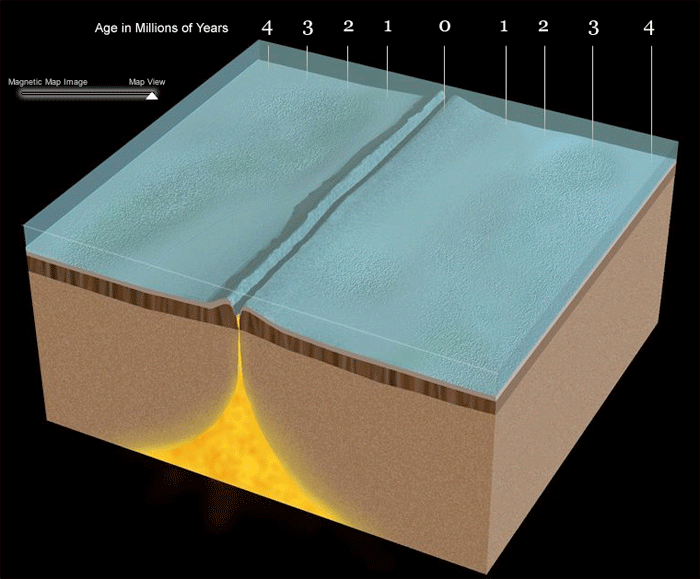Seafloor Spreading Activity
Most basalt magmas contain abundant molten iron. As magma starts to harden into rock, iron-rich minerals solidify first. Their crystals are pulled into alignment by the Earth’s magnetic field, just like a compass needle is pulled towards magnetic north. Once the basalt cools completely into solid rock, the alignment of the iron minerals is fixed. Thus, basalts preserve a permanent record of the strength and direction, or polarity, of the planet’s magnetic field at the time the rocks were formed.
When geologists studied the polarity of ancient rocks, they were stunned to discover that in many of them, iron minerals were aligned toward the south magnetic pole, not the north. Scientists have concluded that the Earth’s magnetic field has reversed itself again and again throughout the ages. When the field points toward the north magnetic pole, as it does today, the field and the rocks that record it have “normal” polarity. When the field points toward the south magnetic pole, opposite of its current behavior, the field and the rocks that record it have “reversed” polarity. All rocks of the same age have the same polarity.
In the 1970's, scientists sailed back and forth across the world’s oceans, measuring the magnetic signatures emanating from the oceanic crust beneath their ships. These surveys revealed a series of invisible magnetic “stripes” of normal and reversed polarity in the sea floor, like that shown in the figure below. The patterns reflect the creation and spreading of oceanic crust along the mid-oceanic ridges. Basalt forming at the ridge crest picks up the existing magnetic polarity. Divergence then moves the swath of fresh crust away from the ridge. As long as the magnetic field remains constant, the polarity “stripe” widens. When the Earth’s magnetic field reverses, a new stripe, with the new polarity, begins.
Such magnetic patterns led to recognition of the occurrence of sea-floor spreading, and they remain some of the strongest evidence for the theory of plate tectonics.
The figure below includes two images of the ocean floor. The map view depicts the visible appearance of the oceanic crust. Click on the image to reveal the magnetic view, which shows the invisible patterns of magnetic polarity contained within the crust. Refer to the figure to answer the questions that follow.
Questions
- Based on the diagram, how many times has the Earth's magnetic field reversed during the past four million years?
[Check Answer]
The Earth's magnetic field has reversed nine times during the past four million years.
- Approximately when did the current interval of normal polarity begin?
[Check Answer]
The current normal polarity began about 800,000 years ago.
- If there had been compasses four million years ago, which direction would compass needles have pointed?
[Check Answer]
The compass needle would have pointed to the south four million years ago.
- Why are the magnetic stripes on the sea floor parallel to and symmetrical across the mid-ocean ridge?
[Check Answer]
New crust forms along the ridge when old crust splits and magma rises to fill the gap. Continued divergence inevitably splits that new crust in its turn, and the broken halves are pushed in opposite directions. Strips of crust form along the ridge, break in half, then spread away from each other. Thus the bands of polarity mirror each other across the ridge.
Additional Information
Albert Einstein called the generation of Earth’s magnetic field one of the greatest mysteries in physics. Scientists are still not sure how the field is generated, though it is clearly related to the movement of molten iron in the liquid outer core. Even more puzzling is why the field switches back and forth between normal and reversed polarity.
The measured strength of the magnetic field has dropped by 5-10% in the last 150 years, and less precise readings suggest it may have weakened by 25-50% over the last 5,000 years. Satellites have detected two areas in the mantle that appear to have reversed polarity. These data have led some to speculate that a magnetic reversal may be imminent.
Critical Thinking
You receive an e-mail offer to get rich quick by investing in an undersea gold mine on top of the Mid-Atlantic Ridge. What scientific issues should you consider before you send a check?Scientists seek to understand and explain how the natural world works. Many of the questions raised in this endeavor have no absolute answers.
Mid-ocean ridges are rich in mineral deposits. Hydrothermal vents are sometimes encrusted with ores of gold, silver, copper, and zinc. The deposits are very young, so the minerals haven’t been degraded by weathering. In one sense, these rocks are easier to get at than many continental deposits – they’re just sitting out on the seafloor, not buried deep underground.
It is also true that these rocks cannot be mined with a pick and a shovel. Mining operations carried out far from land and kilometers underwater will likely require expensive technologies sure to cut into your profit margin. Mid-ocean ridges are also geologically unstable – a mine site would be in constant danger from earthquakes, landslides, and volcanic eruptions. Hydrothermal vents are home not just to minerals, but to small, delicate ecosystems as well. Refining mining techniques to avoid harming vent animals would be expensive, while destroying a vent fauna could lead to public outcry and governmental regulation.
Related Links
Multimedia Discovery Missions: Lesson 2 - Mid-Ocean Ridges


